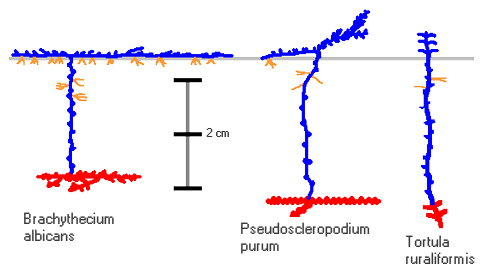Case StudiesMosses and sandSand is widespread in the world. It is found from coastal areas to well inland and may form flat expanses or extensive dune systems. Wind blown sand is a problem in at least two ways. First, moving sand grains are abrasive and capable of damaging bryophytes. Second, blown sand grains eventually come to rest and may do so on bryophytes, thereby threatening to bury them. Given that many bryophytes of sandy areas are low growing, even a light covering would seem capable of blocking access to light and thereby reducing the bryophytes' photosynthesizing capacity. If sand grains are to be blown about then the sand needs to be dry and in dry conditions many bryophyte gametophytes close up in some way. The leaves of mosses may fold up against the stem or curl in around the stem. In closing up, neighbouring leaves typically overlap and this reduces the amount of surface area exposed to abrasion. With the return of moist conditions the leaves unfold or uncurl and, when doing so, can flick away a light cover of sand grains. That done, the exposed leaves are then able to photosynthesize without hindrance. In some cases the re-opening leaves have been seen to flick sand grains away quite vigorously, projecting them several centimetres. That's all very well if there has been a light cover of sand. But what if a moss gametophyte has been covered by more sand than it is able to flick away? There have been some studies into the ability of mosses to survive burial by sand and these have shown that at least some species may survive burial to depths of 1 to 4 centimetres. The following diagrams show some of the results of research carried out in Scotland. The horizontal, pale grey line shows the sand surface, the vertical dark grey line is a scale bar (indicating 2 centimetres) and three buried gametophyte shoots are shown in red. Post-burial gametophyte growth is shown in blue, with rhizoids shown in orange-brown. It took 51 days for the Brachythecium albicans new growth to show above the surface. After another 56 days the growth had reached the extent shown by the leftmost of the diagrams below. In the case of Pseudoscleropodium purum the first surface growth showed 58 days after burial and the middle diagram below shows the total growth after another 112 days. The new Tortula ruraliformis growth showed above the surface 65 days after burial and the rightmost diagram shows the total growth after another 16 days. Of the three mosses, the first two show trailing growth forms and form loose mats on the soil surface, while the Tortula is a tufty species,
The following table shows some of the results of moss burial experiments carried out at Gunnamatta Beach in Victoria. The Scottish experiments noted above were laboratory experiments. In the Victorian study the mosses were buried at the beach and then observed over three months. In the words of the experimenters:
The results for six species, listed in the table's leftmost column, are shown. The blue numbers in the first row show five burial depths. In the body of the table a dash indicates that there was no recovery. Otherwise the first number in each cell shows the "mean % frequency in 2,500 quadrats @ 1x1 cm in 0.5 m 2 grid". The bracketed number shows the time, in weeks, to the emergence of the first shoots.
The Victorians also carried out laboratory experiments with protonemata of Barbula torquata, Bryum billardieri, Tortella cirrhata, Tortula princeps and Triquetrella papillata. These were buried at 0.5 or 1.0 centimetre. For protonemata buried 0.5 cm it took 14-16 days for above-surface growth to show. For protonemata buried 1 cm, the corresponding time was 20-24 days. The point of this case study is ecology, not taxonomy, so I have kept to the species names used in the sources listed below.
|
![An Australian Government Initiative [logo]](/images/austgovt_brown_90px.gif)


